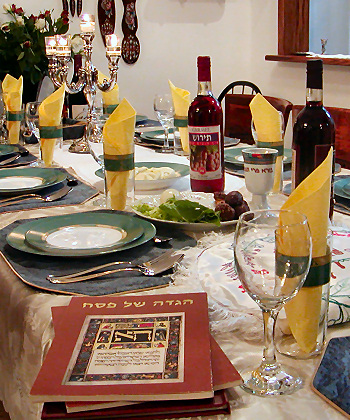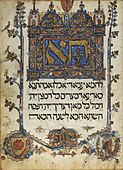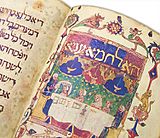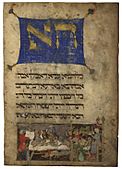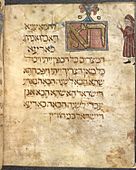Ha Lachma Anya facts for kids
Ha Lachma Anya means "This is the bread of affliction." It's a special saying during the Passover Seder, right at the start of the Magid part. It's written in Aramaic, an old language. This saying helps explain why matzo (a flat, unleavened bread) is so important during the Seder meal.
Contents
The Story Behind Ha Lachma Anya
The Haggadah is a special book used during the Passover Seder. Ha Lachma Anya is a part of this book. Experts believe the Haggadah started a long, long time ago, around the time of the Talmud. There were two main versions of the Haggadah: one from the Land of Israel and one from Babylon.
Today's Haggadahs are mostly based on the Babylonian version. Even though different Jewish groups like Ashkenazic, Sephardic, and Mizrahi Jews have their own versions, the main words of the Haggadah are very similar.
Some people believe Ha Lachma Anya was first said after the Second Temple in Jerusalem was destroyed. Others think it started even earlier, perhaps in the first or second century CE. Some old Haggadahs even added the phrase "we left Egypt hastily" to the beginning of Ha Lachma Anya.
You might also hear "K'Ha Lachma" or "Ha K'Lachma" instead of "Ha Lachma Anya." These mean "This is like the bread of affliction." This small change helps show that the matzah eaten today is a reminder of the bread the Israelites ate in Egypt, not the exact same bread.
How Ha Lachma Anya is Said
During the Magid part of the Passover Seder, families retell the amazing story of the Exodus from Egypt. This is when the Jewish people left slavery in Egypt.
The Magid section begins with an important moment. People uncover and lift the matzo on the Seder table. Then, they recite Ha Lachma Anya. These words are in Aramaic and start by saying, "This is the bread of affliction that our ancestors ate in Egypt."
This tradition comes from the Torah, specifically Deuteronomy 16:3. This verse says that people should eat "unleavened bread, bread of 'ani' (distress)" because they left Egypt quickly. So, Ha Lachma Anya is the first official explanation in the Haggadah for why matzah is eaten.
Inviting Guests to the Seder
The saying of Ha Lachma Anya is also a special invitation. Some Jewish leaders, like Abravanel, taught that it should be said with the door open. This way, poor people could hear the invitation and come join the Seder meal.
In the past, the head of the household would sometimes go outside to say Ha Lachma Anya. This was a way to invite anyone in need to share the Seder with them. It shows the importance of sharing and hospitality during Passover.
Full Text of Ha Lachma Anya
| Aramaic | Transliteration | Translation |
|---|---|---|
|
הָא לַחְמָא עַנְיָא דִי אֲכָלוּ אַבְהָתָנָא בְּאַרְעָא דְמִצְרָיִם. כָּל דִכְפִין יֵיתֵי וְיֵיכֹל, כָּל דִצְרִיךְ יֵיתֵי וְיִפְסַח. הָשַׁתָּא הָכָא, לְשָׁנָה הַבָּאָה בְּאַרְעָא דְיִשְׂרָאֵל. הָשַׁתָּא עַבְדֵי, לְשָׁנָה הַבָּאָה בְּנֵי חוֹרִין. |
Ha lachma anya di achalu avhatana b’ara d’mitzrayim. Kol dichfin yeitei v’yeichol, kol ditzrich yeitei v’yifsach. Hashata hacha, l’shanah habaah b’ara d’Yisrael. Hashata avdei, l’shanah habaah b’nei chorin. |
This is the bread of affliction that our ancestors ate in the land of Egypt. All those who are hungry, let them enter and eat. All who are in need, let them come celebrate the Passover. Now we are here. Next year in the land of Israel. This year we are enslaved. Next year we will be free. |
Gallery


